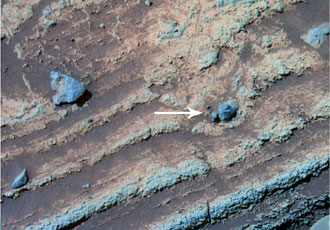The scientists suspect that the explosion that created the Hum Plate layered rock may have been caused by the interaction of basaltic lava and water
 The American Spirit space vehicle, wandering around Mars, discovered evidence of an ancient volcanic eruption in the Home Plate, a plateau consisting of layered rock about 2 meters high in the "inner basin" drum of the Columbia Hills, in the landing area of the robotic vehicle in the Gosev Crater. These are the first remnants of a volcanic eruption identified with high probability so far discovered by Spirit or by its twin - Opportunity.
The American Spirit space vehicle, wandering around Mars, discovered evidence of an ancient volcanic eruption in the Home Plate, a plateau consisting of layered rock about 2 meters high in the "inner basin" drum of the Columbia Hills, in the landing area of the robotic vehicle in the Gosev Crater. These are the first remnants of a volcanic eruption identified with high probability so far discovered by Spirit or by its twin - Opportunity.
"This is strong evidence that these layers were formed as a result of a volcanic eruption," says Steve Squires of Cornell University, the principal investigator of the scientific instruments on the two robotic vehicles on Mars. The findings about the discovery were published in an article in the May 4 issue of the journal Science.
The evidence shows that the area near the Home Plate is dominated by basaltic rocks. "When basalt erupts, it does so in the form of liquid lava, not in an explosion," Squires says. ” “One way for basaltic lava to cause an explosion is when it is in contact with water - the steam pressure causes it to explode.
The scientists suspect that the explosion that created the Hume Plate may have been caused by the interaction of basaltic lava and water. "When you look at the composition of the rock in detail, there are hints that water was involved in the process of its formation" says Sciors. One example is the high chlorine concentration in the rock, which may indicate that the basalt came into contact with salt water.
One of the strongest pieces of evidence for the origin of the Hump Plate is "explosion deposits" preserved in the rock layers, on the lower slopes of the plateau. Leaf blast sediments are formed by volcanic explosions on Earth when rocks are thrown skyward in an explosion and fall onto soft sediments, changing their composition after falling.
Spirit arrived at Home Plate in February 2006 and spent several months exploring it in detail before going to Low Ridge to rest for the winter. Spirit has now returned to Home Plate to continue research there. "We decided to return to Home Plate as soon as the red winter is over because it is one of the interesting areas we found in Gusev Crater" says Sciors. Last year we started exploring the northern and eastern sides of the plateau. Now we intend to explore the southern and eastern areas. Spirit's ongoing research at Home Plate will primarily focus on testing the idea that water was involved in its creation process.

One response
so…?